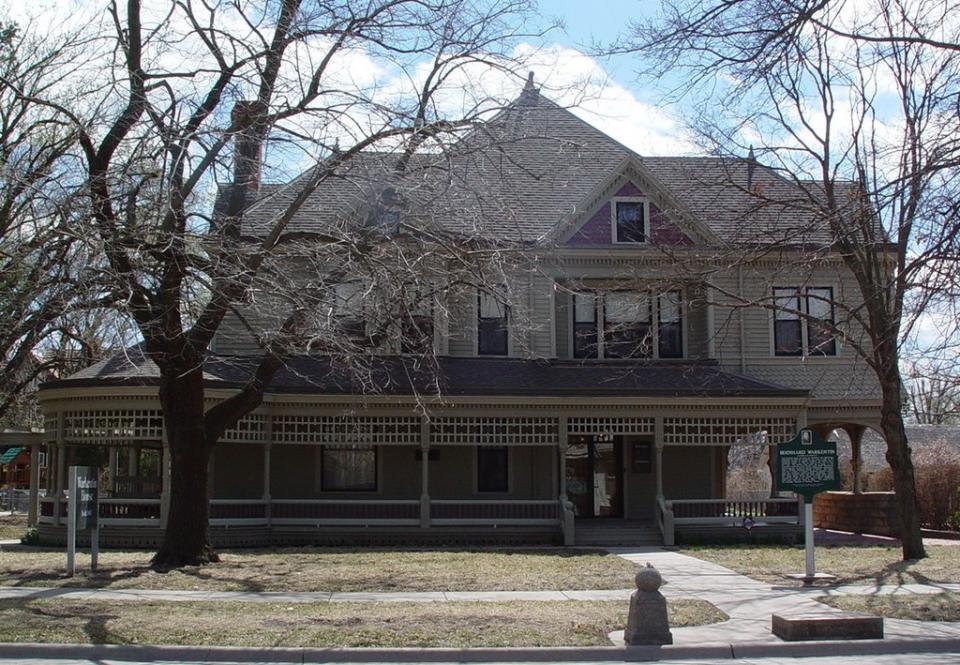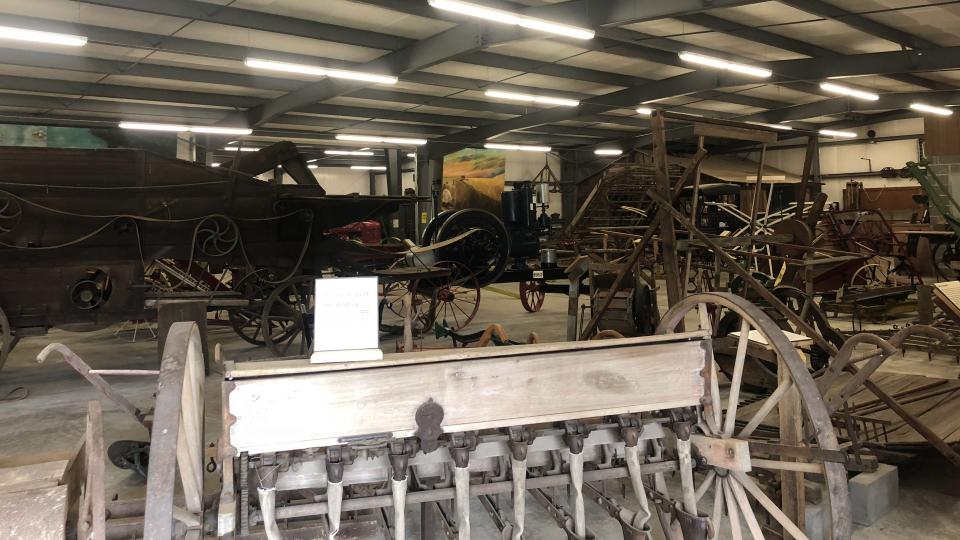In nineteenth-century Kansas, a strain of wheat grew. Golden ears rustled in the breeze as storm-laden skies darkened to purple, cicadas singing in the grass. The grain was Turkey Red, originating far from the American prairies, a hardy winter wheat grown by Mennonites in Ukraine and transported to North America. If you ask people to describe Mennonites, they think of farmers, fields, and traditional dress. The connection between Mennonites and the wistful romanticizing of rural life is powerful. But this idea of agrarian peace is misleading. It suggests harmonious relationships with the land, living within one’s means and with nature. The reality is more complicated, and nostalgia hides darker realities. Farming transformed Kansas into America’s breadbasket, but it also had a devastating environmental impact. Less than 4% of North American tallgrass prairie remains.

Restored tallgrass prairie outside the Kauffman Museum, North Newton, Kansas. The museum has displays that relate the European origins of Mennonites and stories of migration. However, collections and exhibitions also deal with the more difficult history of the area, such as the collections related to the Cheyenne people and the story of bison.
Restored tallgrass prairie outside the Kauffman Museum, North Newton, Kansas. The museum has displays that relate the European origins of Mennonites and stories of migration. However, collections and exhibitions also deal with the more difficult history of the area, such as the collections related to the Cheyenne people and the story of bison.
© 2018 Kat Hill
Used by permission
The copyright holder reserves, or holds for their own use, all the rights provided by copyright law, such as distribution, performance, and creation of derivative works.
In the late nineteenth century, Mennonites from modern-day Ukraine, who spoke Plautdietsch, a German dialect, boarded ships crossing the Atlantic. The first wave arrived in New York in 1874 and journeyed to Marion County, Kansas, to find a place where they could live, farm, and worship, supported by the Atchison, Topeka and Santa Fe Railway Company, which provided temporary housing and travel. The Mennonite Heritage Museum in Goessel, Kansas, narrates their movement and settlement with cases of material objects of migration, re-creations of immigrant huts, and displays of agricultural machinery. In the surrounding fields, where the Alexanderwohl Mennonite Church gleams white against blue skies, the Mennonite legacy is evident. Farmed fields stretch to the horizon. As David Moon argues, Turkey Red’s legend is deeply ingrained in Kansas and Mennonite histories, but Mennonites may not have been the first to transport it. The story was never as simple as a few seeds in a chest. However, once winter wheat from the Russian Empire arrived, Mennonites became responsible for large-scale production, turning Kansas prairies into wheatfields. Bernard Warkentin (1841–1908), who cooperated with the US Department of Agriculture’s Mark Carleton to experiment with varieties, was praised in the Saturday Evening Post in 1910 “for making Kansas a great wheat state.” His impressive house still stands in Newton.

The home of Bernhard Warkentin, Newton, Kansas.
The home of Bernhard Warkentin, Newton, Kansas.
Photograph by Erinmcd, 11 April 2007. Click here to view source.
 This work is licensed under a Creative Commons Public Domain Mark 1.0 License.
This work is licensed under a Creative Commons Public Domain Mark 1.0 License.
Kansas became the grain-growing heartland of the US, and the effects on existing environments were devastating. Until the early 1800s, North America had 240 million acres of tallgrass prairie, a rich, biodiverse ecosystem that supported life from prairie mole crickets to bison and where indigenous Great Plains people lived off the land. Within two generations, by the 1930s, this was largely destroyed. We cannot now imagine the humming life that existed in these vanished worlds of grass seas. Mennonites were not the only settlers to transform “the Great American Desert” into agricultural land, but they were part of the process. Today, outside the Kauffman Museum in North Newton, Kansas, a patch of restored tallgrass prairie grows. This museum is dedicated to the culture and history of the prairies, and particularly to Mennonite stories. I wandered through waving grasses on a warm August afternoon, alive with insects, buzzing echoes of lost landscapes.

Display of farming machinery at the Mennonite Heritage Museum, Goessel, Kansas. The website and displays provide examples of the some of the nostalgic narratives about the importance of Turkey Red wheat and its history, stating the story is important so that people who eat bread “know about the value of Turkey Red.”
Display of farming machinery at the Mennonite Heritage Museum, Goessel, Kansas. The website and displays provide examples of the some of the nostalgic narratives about the importance of Turkey Red wheat and its history, stating the story is important so that people who eat bread “know about the value of Turkey Red.”
© 2018 Kat Hill
Used by permission
The copyright holder reserves, or holds for their own use, all the rights provided by copyright law, such as distribution, performance, and creation of derivative works.
As damaging as the destruction of the prairies, and crucial to the reason for this transformation, is the social relationship with the land that evolved from this “prairie pioneer” religious mentality. The construct of the American wilderness emerged from the settlers’ perception that the world they came to was ripe for appropriation and cultivation. On a trip to Kansas in 1873, Christian Krehbiel described his surroundings: “an expanse of the best land, watered by various smaller and larger streams … luxurious growth of grass.” He had “room only for one thought,” that Mennonites had chosen well and could settle “without any reservations.” Krehbiel commented, too, on enormous buffalo bone heaps in Colorado but remarked that “their time has passed,” for men’s efforts “transformed these wastes into beautiful homes.” It is not novel to suggest that Christian theology can imply dominion over nature, but the Mennonite story reveals how this became entangled with nostalgia for American pasts. Mennonites earned a reputation as guardians of “traditional” farming values. Seeds and their stories, as Susie Fisher’s work on Manitoba reveals, are central to Mennonite memory cultures and intergenerational relationships to place. However, connections with the land that evolved, enshrined in myths of migrating seeds, shaped environmental imaginaries concerned with production, consumption, and taming land. This ethic is clear in large-scale industrial farming, extracting as much as possible at low cost. But the same sentiment permeates wistful ideals about agrarian settlement. When Europeans arrived in the Plains, including Mennonites who planted winter wheat in Kansas, it symbolised a turning point in the perception of the prairies. As Anna Tsing argues, the interdependent relationship between wheat and humanity is a long love affair, producing hierarchies of dominance and order.
On leaving the Goessel Museum, I received a vial of grain. The tiny object symbolised nostalgia for an agrarian past, seemingly peaceful but violent to the environment. 1874 is not the only time that Mennonites impacted the environment or indigenous communities who have a different relationship with the land. In Paraguay, Mennonites tamed the Gran Chaco’s dangerous shrublands, often known as the “Green Hell,” pushing out indigenous communities, clearing forest, and later creating soy plantations for beef. In 1938, Harold Bender described the “thick Brazilian forest … never touched by the hand of man,” ripe for settlement. Mennonites are not the central villains but one strand in the narrative of how humans have degraded landscapes in America and beyond. However, Turkey Red’s myth serves as a reminder of both environmental damage and damage done by stories we tell about the environment, idealizing control and dominion. Behind the wistful idea of poor migrants arriving with few possessions and handfuls of wheat, a version of the American Dream, is a more troubling narrative of human-centered stories about the environment and the land.
How to cite
Hill, Katherine. “Golden Grains: Environmental Implications of Mennonite Migration to Kansas in the Late Nineteenth Century.” Environment & Society Portal, Arcadia (Summer 2022), no. 10. Rachel Carson Center for Environment and Society. doi:10.5282/rcc/9434.
ISSN 2199-3408
Environment & Society Portal, Arcadia
 This work is licensed under a Creative Commons Attribution 4.0 International License.
This work is licensed under a Creative Commons Attribution 4.0 International License.
2022 Katherine Hill
This refers only to the text and does not include any image rights.
Please click on the images to view their individual rights status.
- Bender, Harold S. “With the Mennonite Refugee Colonies in Brazil and Paraguay: A Personal Narrative.” Mennonite Quarterly Review 13 (1939): 59–70.
- Fisher, Susie. “(Trans)planting Manitoba’s West Reserve: Mennonites, Myth, and Narratives of Place.” Journal of Mennonite Studies 35 (2017): 127–48.
- Fullilove, Courtney. The Profit of the Earth: The Global Seeds of American Agriculture. Chicago: Chicago University Press, 2017.
- Krehbiel, Christian. Prairie Pioneer: The Christian Krehbiel Story. Newton: Faith and Life Press, 1961.
- Loewen, Royden. Mennonite Farmers: A Global History of Place and Sustainability. Baltimore: Johns Hopkins University Press, 2021.
- Moon, David. The American Steppes: The Unexpected Russian Roots of Great Plains Agriculture, 1870s–1930s. Cambridge: Cambridge University Press, 2020.
- Tsing, Anna. “Unruly Edges: Mushrooms as Companion Species.” Environmental Humanities 1, no. 1 (2012): 141–54.









